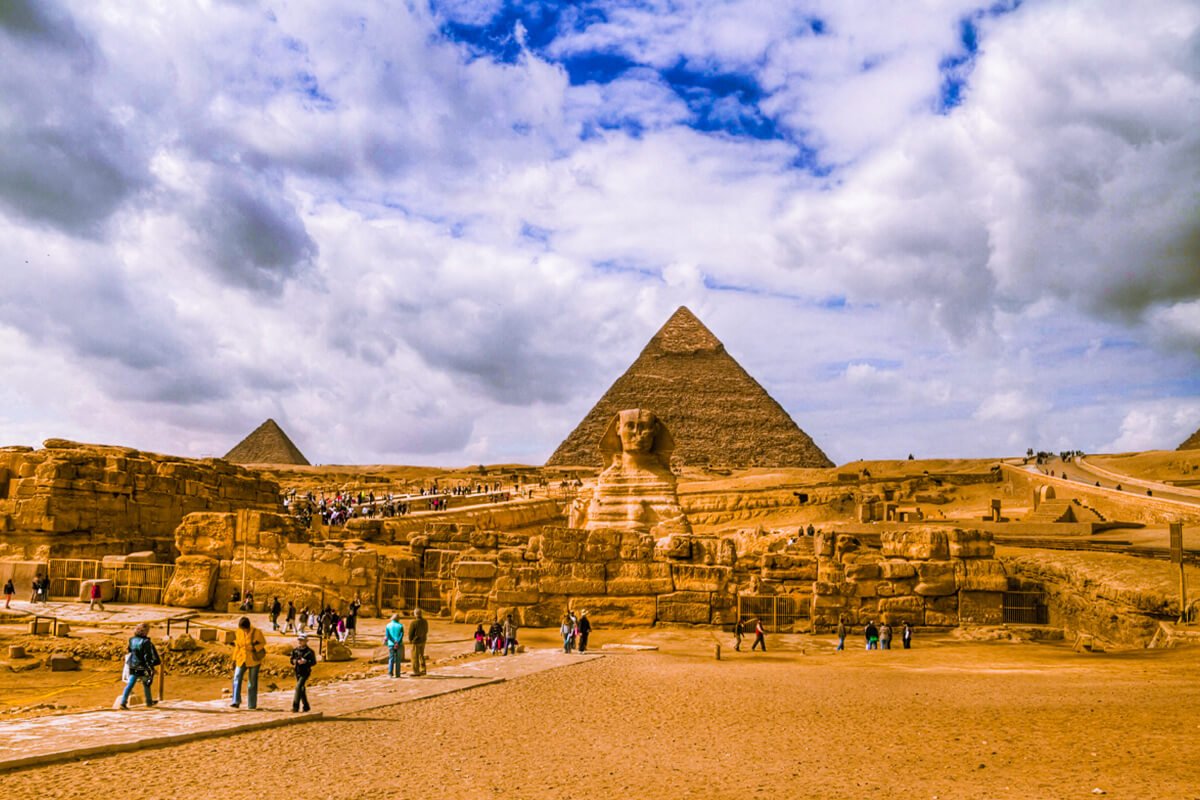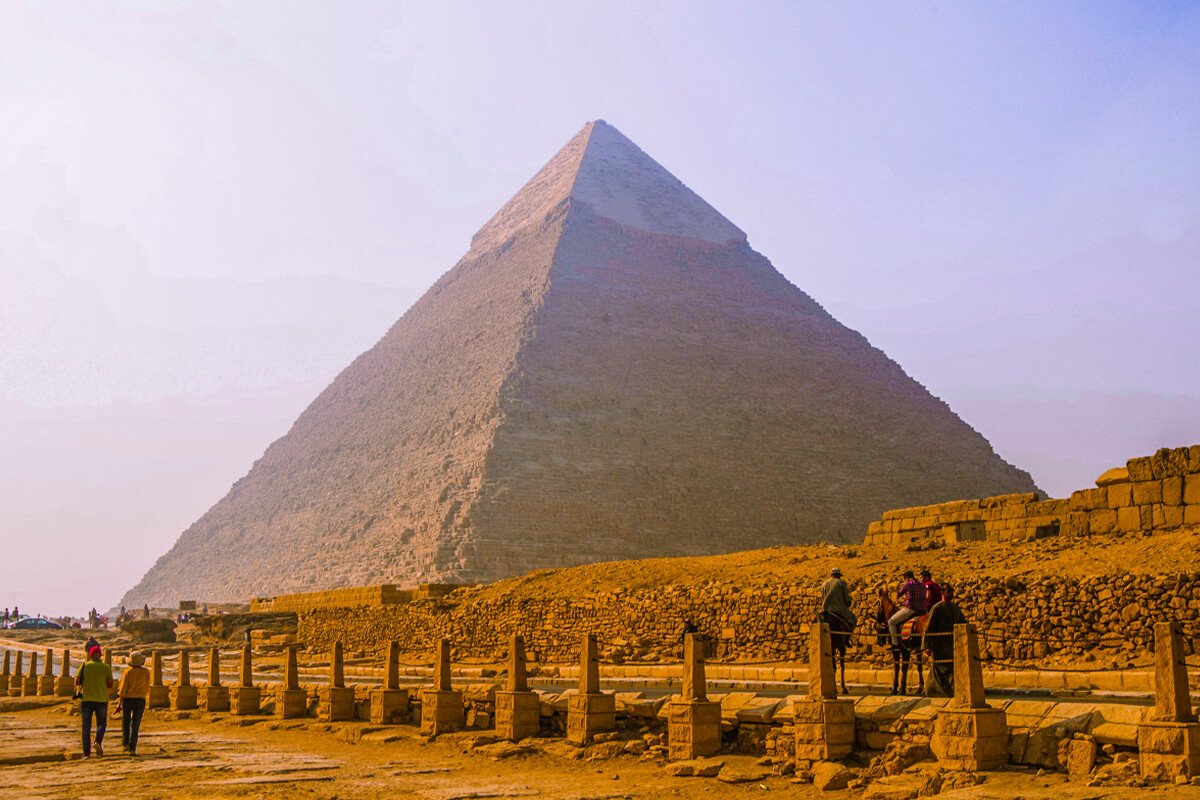Pyramid of Khafre on the Giza Plateau: Exploring the Enigma
The Pyramid of Khafre is a beautiful monument to ancient Egypt’s splendor, and it stands proudly among the windswept sands of the Giza Plateau. Over 4,500 years after its completion, this massive structure still mystifies and fascinates historians, archaeologists, and the curious. In this in-depth investigation, we uncover its architectural wonders, analyze Pharaoh Khafre’s legacy, and explore the Pyramid of Khafre’s deep purpose. Join us as we explore the history and mysteries of this impressive edifice.
Discover Egypt’s ancient wonders! Book your Egypt Packages now!
Construction The Pyramid of Khafre
The Pyramid of Khafre, believed to have been constructed during the Old Kingdom period of ancient Egypt, carries the weight of antiquity on its massive shoulders. Its construction is thought to have occurred around 2570 BC, during the Fourth Dynasty of the Old Kingdom, when Egypt’s power and sophistication were at their zenith. This epoch is synonymous with constructing numerous pyramids, but Khafre’s monument stands out as a symbol of the Pharaoh’s grandeur and technological prowess.
The Pyramid of Khafre, believed to have been constructed during the Old Kingdom period of ancient Egypt, carries the weight of antiquity on its massive shoulders. Its construction is thought to have occurred around 2570 BC, during the Fourth Dynasty of the Old Kingdom, when Egypt’s power and sophistication were at their zenith. This epoch is synonymous with constructing numerous pyramids, but Khafre’s monument stands out as a symbol of the Pharaoh’s grandeur and technological prowess.

Experience the magic of Egypt with our luxurious Nile Cruises!
Architectural Features
- Limestone Casing
One of the most striking features of the Pyramid of Khafre is its outer casing of gleaming Tura limestone. This polished layer, while now largely eroded, would have once dazzled under the Egyptian sun. Its precision and finesse speak volumes about the craftsmanship of the builders. Limestone casing, with its exceptional smoothness, was not just an aesthetic choice but a symbol of purity, reflecting the Egyptian belief in the divine nature of the Pharaoh.
- Mortuary Temple
Adjacent to the Pyramid lies the magnificent Mortuary Temple, a structure designed to serve as a place of rituals and offerings to honor the deceased Pharaoh. The temple’s inner sanctum, adorned with intricate carvings and sculptures, was dedicated to Pharaoh Khafre. This temple was an integral part of the funerary complex, ensuring the Pharaoh’s eternal well-being and commemoration.
- Valley Temple
Linked to the Mortuary Temple by a causeway, the Valley Temple is another architectural wonder. Built with massive blocks of granite, this temple bears witness to the engineering skills of the ancient Egyptians. It served as the entry point for the Pharaoh’s procession and the embalming process, reinforcing the belief in the seamless journey from life to the afterlife.
The Pharaoh, Khafre: Pharaoh’s Role
Pharaoh Khafre, whose name means “Appearing Like Ra,” was the fourth ruler of the Fourth Dynasty. The Pharaoh occupied a unique and pivotal position in Egyptian society. Seen as a living god and the intermediary between the people and the divine, he was not only the political leader but also the spiritual leader of Egypt. The construction of the Pyramid of Khafre was not only a testament to his power but also a reflection of his divine duty to ensure the harmony and prosperity of the land.
Legacy and Achievements
Khafre’s reign is characterized by his ambitious building projects, with the Pyramid of Khafre and the Great Sphinx being the most renowned. His commitment to preserving Egypt’s spiritual and political unity is a testament to his prowess as a ruler. The Pyramid is a testament to his legacy, a monument that symbolizes his eternal rule, and an icon of Egypt’s grandeur.
Theories Surrounding His Reign
Khafre’s reign, like many aspects of ancient Egypt, is not without its mysteries and controversies. Historians and archaeologists have debated the extent of his achievements, the role of his successor, Menkaure, and the purpose behind the monumental structures he left behind. Some suggest that his reign marked a shift toward centralized power, while others ponder the true meaning of the Pyramids and their alignment with celestial bodies.
Experience Egypt in a day. Your journey starts here. Egypt Day Tours.
The great pyramidal edifice
Built with exactness and mathematical knowledge, the Pyramid of Khafre is a massive tower with a square foundation of around 215 meters (705 feet) on each side. Its height has decreased significantly from its initial 143.5 meters (471 feet), but it still stands tall. Considering the level of technology available at the time, it is remarkable that the Egyptians could achieve such precise geometric alignment.
- Alignment with Celestial Bodies
Astronomy played a significant role in ancient Egypt, and the Pyramids’ alignment with celestial bodies suggests a profound connection to the cosmos. The pyramid’s sides are aligned with the cardinal points, closely following the north-south and east-west axes. Some scholars argue that this precise alignment was intended to connect the Pharaoh’s journey in the afterlife with the stars, reinforcing his divine status.
Inside the Pyramid of Khafre
- King’s Chamber
Deep within the pyramid’s core lies the King’s Chamber, a room of unparalleled importance. This chamber, carved from red granite, houses the Pharaoh’s sarcophagus. The King’s Chamber is a sacred space, symbolizing the Pharaoh’s journey to the afterlife and his union with the divine. Its construction involved immense logistical challenges, highlighting the advanced engineering of the time.
- Queen’s Chamber
In contrast to the King’s Chamber, the Queen’s Chamber remains a source of intrigue and debate. Its purpose has yet to be definitively understood, but it is believed to have had a symbolic or ceremonial role. The chamber’s design and location within the pyramid add to the enigma surrounding its function.
Building Techniques
- Tools and Materials
The construction of the Pyramid of Khafre was a monumental feat, made possible through innovative tools and abundant raw materials. The builders utilized copper chisels, dolerite pounders, and wooden sleds to quarry the massive stone blocks, many of which were sourced locally. Using levers and counterweights for lifting and positioning these blocks was a testament to the builders’ ingenuity.
- Workforce and Labor
The sheer scale of the Pyramid of Khafre demanded an enormous workforce, primarily composed of skilled laborers and unskilled workers. The skilled artisans and architects who oversaw the project were revered, while the unskilled laborers toiled tirelessly to move the colossal stone blocks into place. This labor force was not one of oppression but rather a collective effort driven by a shared belief in the Pharaoh’s divinity.
Curious about Egypt Shore Excursions? Let’s answer your questions.
The Sphinx and Connection to Pyramid of Khafre

The Great Sphinx, a colossal limestone statue with the body of a lion and the head of a Pharaoh, has a profound connection to Khafre. It is widely believed to represent Pharaoh Khafre, serving as his divine guardian in the afterlife. The Sphinx, with its enigmatic smile, gazes eternally towards the rising sun, symbolizing the Pharaoh’s immortality.
- Symbolism and Mysteries
The Sphinx, much like the Pyramids, is a source of mystery and intrigue. Its purpose and the intricate details of its construction continue to puzzle researchers. Some theories suggest that it was not only a guardian but also a marker for celestial events, such as the equinoxes. The symbolism behind its form, part lion representing strength and part human representing the Pharaoh’s divinity, is a testament to the intricacy of Egyptian religious beliefs.
- Religious Significance
The Pyramid of Khafre held profound religious significance in ancient Egypt. It was not merely a tomb but a sacred structure intended to facilitate the Pharaoh’s journey to the afterlife. The pyramids were a physical representation of the Pharaoh’s divine connection and a conduit for his spirit to ascend to the heavens. The rituals and ceremonies surrounding the pyramid’s construction and associated temples reinforced this spiritual connection.
- Funerary Aspects
The complex funerary rituals associated with the Pyramid of Khafre were intricate and meticulously planned. The offerings, inscriptions, and ceremonies conducted in the Mortuary and Valley Temples were essential for ensuring the Pharaoh’s eternal well-being. These rituals included the “Opening of the Mouth” ceremony, which allowed the Pharaoh to breathe and eat in the afterlife, ensuring his continued existence.
Recent Archaeological Findings
Modern archaeology continues to uncover secrets hidden within the Pyramid of Khafre. Recent excavations have revealed previously undiscovered chambers and passageways within the pyramid’s structure. These findings shed new light on the purpose and design of the pyramid, leaving researchers with more questions than answers.
In the 21st century, cutting-edge technology has allowed us to explore the Pyramid of Khafre in unprecedented detail. Ground-penetrating radar, drones, and 3D scanning have provided a non-invasive means of investigating the pyramid’s interior and the surrounding Giza Plateau. These advancements have opened up new possibilities for understanding the pyramid’s construction and purpose, as well as the mysteries of ancient Egypt.
Related FAQs about the Pyramid of Khafre
How was the Pyramid of Khafre built?
The construction of the Pyramid of Khafre was massive. Using copper chisels, dolerite pounders, and wooden sleds, skilled workers quarried large stone blocks. Levers and counterweights helped raise and place these gigantic stones, demonstrating the builders’ inventiveness and collaboration.
What is the significance of the Sphinx?
The Great Sphinx’s lion body and Pharaoh’s head represent Khafre’s mystical link to the afterlife. It guards him forever and marks cosmic happenings. The Sphinx’s mysterious grin and cosmic alignment enhance its symbolism.
Can visitors enter the underground chambers?
The Pyramid of Khafre’s subterranean rooms are open to tourists. These include the King’s Chamber, the Queen’s Chamber, and passages. Visitors may enter, but the tight, poorly lit corridors make it an adventure.
What are the latest discoveries about the Pyramid?
Recent archaeological digs revealed the Pyramid of Khafre rooms and tunnels. These discoveries have raised doubts regarding the Pyramid’s construction, function, and ancient Egyptian beliefs. Ground-penetrating radar and 3D scanning are revealing more secrets about this old masterpiece.
Conclusion
As we conclude this journey through the Pyramid of Khafre, its significance reverberates through the annals of history. This colossal monument, an architectural marvel and testament to the power of a pharaoh, serves as an enduring symbol of ancient Egypt’s grandeur. Khafre’s legacy is etched in stone, and his pyramid bridges the earthly realm and the celestial heavens. The timelessness of ancient Egypt, its profound beliefs, and its awe-inspiring architecture continue to captivate the world, making the Pyramid of Khafre a majestic relic of a bygone era.
Hike the Egyptian Desert: Secure Your Egypt Desert Safari Tours!



